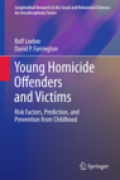
Young homicide offenders and victims: risk factors, prediction, and prevention from childhood
Loeber, Rolf
Farrington, David P.
The first decade of the new century proved to be a deadly one for many children and young people in the United States. Despite increased policing on the streets, higher rates of incarceration, harsher sentencing, stricter control of illegal drugs, and attempts to reduce access to firearms, FBI reports show that more than 7,300 young people between the ages of 15 and 29 were murdered in 2008 alone. It’s clear that traditional crime reduction strategies have not stemmed the rising tide of homicides perpetrated by and upon one of society’s most vulnerable populations. Innovative, practicable solutions are needed to staunch this lethal trend. Based on the findings of a unique longitudinal study, Young Homicide Offenders and Victims: Risk Factors, Prediction, and Preventionfrom Childhood now provides experts with unprecedented analysis of prospectively collected data on 1,517 boys and young men who grew up in Pittsburgh, Pennsylvania. Following these males from childhood into early adulthood, examiningtheir lives and the conditions under which they grew up in a representative mid-sized American city, the study forms the basis of this unique volume designed to stimulate debate on key questions of prevention and intervention as wellas dispel popular myths about the childhood and adolescent features of homicide offenders and homicide victims. Key areas of coverage include: • Early childhood risk factors of young homicide offenders and victims. • Insights into homicide offenders’ lives as told in their own words. • The effectiveness of screening for at-risk youth. • Risk factor–based prevention and intervention strategies. • The impact of interventions on homicide rates. • Policy implicationsat the local, state, and national levels. Young Homicide Offenders and Victims: Risk Factors, Prediction, and Prevention from Childhood is essential reading for researchers, practitioners, and policy makers across the fields of juvenile justice and criminology, developmental psychology, sociology, psychiatry, public health, and policy making. Focuses on homicides by young in U.S. inner cities (the location, nationally, where most homicides take place) and is based on longitudinal, prospectiveinformation.. Offers data that has been collected on violence and homicide using both self-reports and official records throughout many years.. Covers comprehensive coverage of both offenders and victims of homicidal crimes.. Followsa broad range of ages, from early childhood through adolescence.. Examines trends unique crime among U.S. youth, but its overall findings and recommendations are applicable worldwide.. . INDICE: Foreword by Kathleen Heide. Foreword by Irvin Waller. Preface. Young Male Homicide Offenders and Victims: Current Knowledge, Beliefs, and Key Questions. The Pittsburgh Youth Study. Homicide, Offenders, and Victims in the United States, Pennsylvania, Pittsburgh, and the Pittsburgh Youth Study. Early Risk Factors for Convicted Homicide Offenders and Homicide Arrestees. Prediction of Homicide Offenders out of Violent boys. Early Risk Factors for Homicide Victims and Shooting Victims. Homicide Offenders Speak. Modeling the Impact ofPreventive Interventions on the National Homicide Rate. Modeling the Impact of Interventions on Local Indicators of Offending, Victimization and Incarceration. Conclusions and Implications.
- ISBN: 978-1-4419-9948-1
- Editorial: Springer US
- Encuadernacion: Cartoné
- Páginas: 250
- Fecha Publicación: 29/08/2011
- Nº Volúmenes: 1
- Idioma: Inglés
